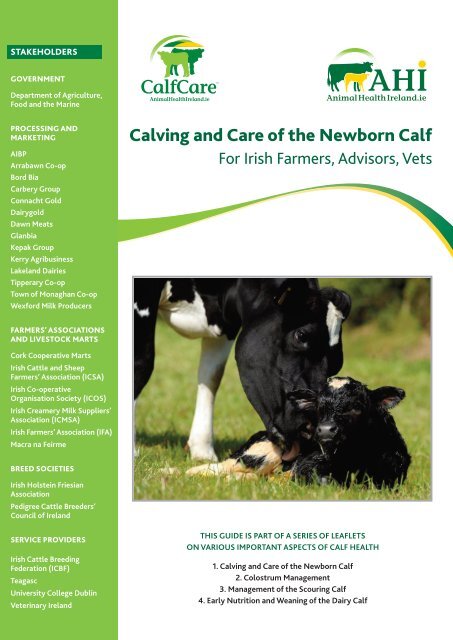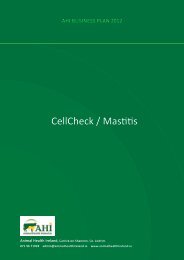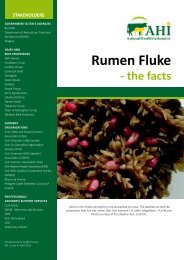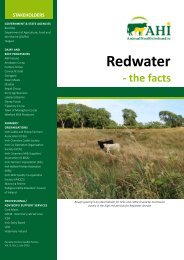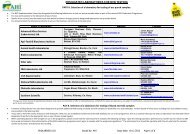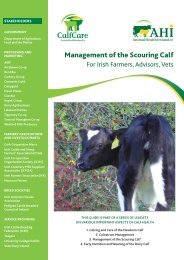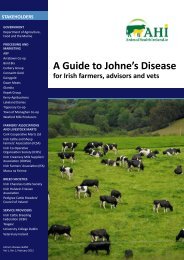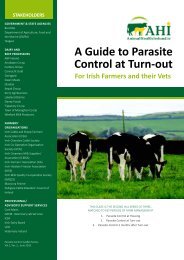Calving and Care of the Newborn Calf - Animal Health Ireland
Calving and Care of the Newborn Calf - Animal Health Ireland
Calving and Care of the Newborn Calf - Animal Health Ireland
Create successful ePaper yourself
Turn your PDF publications into a flip-book with our unique Google optimized e-Paper software.
STAKEHOLDERS<br />
GOVERNMENT<br />
Department <strong>of</strong> Agriculture,<br />
Food <strong>and</strong> <strong>the</strong> Marine<br />
PROCESSING AND<br />
MARKETING<br />
AIBP<br />
Arrabawn Co-op<br />
Bord Bia<br />
Carbery Group<br />
Connacht Gold<br />
Dairygold<br />
Dawn Meats<br />
Glanbia<br />
Kepak Group<br />
Kerry Agribusiness<br />
Lakel<strong>and</strong> Dairies<br />
Tipperary Co-op<br />
Town <strong>of</strong> Monaghan Co-op<br />
Wexford Milk Producers<br />
FARMERS’ ASSOCIATIONS<br />
AND LIVESTOCK MARTS<br />
Cork Cooperative Marts<br />
Irish Cattle <strong>and</strong> Sheep<br />
Farmers’ Association (ICSA)<br />
Irish Co-operative<br />
Organisation Society (ICOS)<br />
Irish Creamery Milk Suppliers’<br />
Association (ICMSA)<br />
Irish Farmers’ Association (IFA)<br />
Macra na Feirme<br />
BREED SOCIETIES<br />
Irish Holstein Friesian<br />
Association<br />
Pedigree Cattle Breeders’<br />
Council <strong>of</strong> Irel<strong>and</strong><br />
SERVICE PROVIDERS<br />
Irish Cattle Breeding<br />
Federation (ICBF)<br />
Teagasc<br />
University College Dublin<br />
Veterinary Irel<strong>and</strong><br />
TM<br />
<strong>Calving</strong> <strong>and</strong> <strong>Care</strong> <strong>of</strong> <strong>the</strong> <strong>Newborn</strong> <strong>Calf</strong><br />
For Irish Farmers, Advisors, Vets<br />
THIS GUIDE IS PART OF A SERIES OF LEAFLETS<br />
ON VARIOUS IMPORTANT ASPECTS OF CALF HEALTH<br />
1. <strong>Calving</strong> <strong>and</strong> <strong>Care</strong> <strong>of</strong> <strong>the</strong> <strong>Newborn</strong> <strong>Calf</strong><br />
2. Colostrum Management<br />
3. Management <strong>of</strong> <strong>the</strong> Scouring <strong>Calf</strong><br />
4. Early Nutrition <strong>and</strong> Weaning <strong>of</strong> <strong>the</strong> Dairy <strong>Calf</strong>
2<br />
If any <strong>of</strong> your full-term calves are stillborn or die within 24 hours, or if calves are too weak to drink after birth<br />
you should investigate <strong>the</strong> points laid out in this leaflet <strong>and</strong> discuss what might be <strong>the</strong> underlying problems<br />
with your local vet. In carrying out any investigation, it may be necessary for your vet to submit relevant<br />
samples (e.g. calf carcasses, placentas, blood samples) to your local veterinary laboratory.<br />
What can you do in advance to PREVENT calving problems?<br />
Well<br />
grown first<br />
calvers are<br />
essential<br />
• Ensure your heifers are big enough at calving<br />
Heifers should have reached at least 60 – 65% <strong>of</strong> <strong>the</strong>ir mature body weight at<br />
breeding, should be calving at 24 months <strong>of</strong> age, <strong>and</strong> should have attained 90% <strong>of</strong> <strong>the</strong><br />
mature body weight <strong>of</strong> your mid-lactation 4 year old cows.<br />
Tip: weigh some <strong>of</strong> your mid-lactation four year old cows as a guide to mature body<br />
weight.<br />
• Choose an easy calving sire<br />
On average, some breeds will have more<br />
difficult calvings than o<strong>the</strong>r breeds; this is<br />
particularly true for beef breeds.<br />
There is as much variation between individual<br />
sires within a breed, as <strong>the</strong>re is between breeds<br />
for calving difficulty, gestation length <strong>and</strong><br />
stillbirth rate.<br />
When choosing an AI sire, comparing <strong>the</strong><br />
economic breeding index (EBI) is as important<br />
as <strong>the</strong> breed you choose. With stock bulls,<br />
without such genetic information, <strong>the</strong>re can be<br />
a greater risk <strong>of</strong> unknown calving dates, calving<br />
problems, big calves <strong>and</strong> calf losses.<br />
• Make sure your cows <strong>and</strong> heifers are nei<strong>the</strong>r too fat nor too thin at calving<br />
Aim to manage <strong>the</strong> body condition at calving to reach values between 3.0 <strong>and</strong> 3.5 for dairy <strong>and</strong> 2.75 to<br />
3.25 for suckler cows (5-point scale).<br />
• Feed a balanced diet during pregnancy<br />
Imbalances in minerals, particularly calcium, magnesium, potassium, iodine <strong>and</strong> selenium, can occur with<br />
home-grown forage-only diets. Provide supplementary minerals <strong>and</strong> vitamins during <strong>the</strong> last two months<br />
<strong>of</strong> pregnancy.<br />
Plan<br />
your calvings<br />
to minimise<br />
problems<br />
Regular weighing will ensure you know your heifers are on target<br />
Be aware that a straw-only diet can reduce colostrum quality in your cows.<br />
• Control calving date<br />
Calves grow very fast in <strong>the</strong> last period <strong>of</strong> pregnancy. If you have cows going over <strong>the</strong><br />
due date <strong>and</strong> you fear difficult calvings due to oversized calves, discuss controlling <strong>the</strong><br />
calving date with your local vet.<br />
• Control infectious diseases<br />
Be aware that stillborn, weak or sick calves can also be caused by infections <strong>of</strong> <strong>the</strong><br />
cow. Discuss <strong>the</strong> appropriate strategies (vaccination/eradication) for your herd with<br />
your local vet.
3<br />
How can you MANAGE CALVINGS to reduce calving problems <strong>and</strong><br />
calf losses?<br />
1<br />
2<br />
3<br />
Calve all heifers <strong>and</strong> cows in a calving unit<br />
Clean<br />
calving pens<br />
<strong>and</strong> housing to<br />
minimise<br />
disease<br />
<strong>Calving</strong> facilities should be clean, well-bedded <strong>and</strong> well-illuminated <strong>and</strong> have an adequate<br />
supply <strong>of</strong> clean water. They should be equipped with a self-locking restraining gate (preferably<br />
suitable for Caesarean Section) <strong>and</strong> should not be used to accommodate sick cattle.<br />
Individual calving boxes are preferable. Depending on <strong>the</strong> precalving movement policy, <strong>the</strong><br />
calving pattern <strong>and</strong> <strong>the</strong> residency time in <strong>the</strong> pen, at least one individual calving pen (4m<br />
by 4m) may be required per 25 cows.<br />
Well-managed, group-calving units (loose pens, pads, paddocks) can also provide suitable calving<br />
accommodation. (See AHI website www.animalhealthirel<strong>and</strong>.ie regarding issues on Johne's Disease <strong>and</strong> group<br />
calving facilities.)<br />
Move pregnant animals to <strong>the</strong> calving unit before calving begins<br />
• Moving pregnant animals to <strong>the</strong> calving unit before calving begins reduces stress at calving, which can be<br />
a particular problem in heifers.<br />
• Inspect <strong>the</strong> animals near to calving (based on breeding/pregnancy detection records) at least twice daily,<br />
<strong>and</strong> move <strong>the</strong>m into <strong>the</strong> calving unit when you detect signs <strong>of</strong> impending calving (see below).<br />
• If a cow is already ‘sick to calve', when first observed, it may be better to wait until she has started to calve<br />
(waterbag or foetal hooves are visible) before moving her into <strong>the</strong> calving unit. This advice applies<br />
particularly in <strong>the</strong> case <strong>of</strong> heifers.<br />
Signs that calving is close:<br />
o s<strong>of</strong>tening <strong>of</strong> <strong>the</strong> pin bone<br />
ligaments<br />
o swollen udder<br />
o dripping colostrum.<br />
Observe all calvings if possible<br />
Observe<br />
all calvings if<br />
possible<br />
‘Sick to calve’ signs to look for:<br />
o tail raised<br />
o mucus at vulva<br />
o restless - st<strong>and</strong>ing <strong>and</strong> lying<br />
frequently.<br />
• If cows are 'sick to calve', keep a discreet eye on <strong>the</strong>m every two hours. Do not move,<br />
disturb or unnecessarily h<strong>and</strong>le cows during this period. Supervision does not imply<br />
intervention, as most calvings do not require assistance.<br />
• Keep a particularly close eye on high-risk calvings or calvings which are likely to be<br />
prolonged, e.g. overfat heifers, heifers in calf to a sire known to produce big calves, cows<br />
carrying twins <strong>and</strong> cows with a history <strong>of</strong> milk fever.<br />
• <strong>Calving</strong> cameras can be a useful aid to reduce <strong>the</strong> workload involved in 24h calving supervision <strong>and</strong> to<br />
avoid disturbing <strong>the</strong> calving, particularly for heifers which are more sensitive to stress.<br />
• Evening or nightime feeding can reduce, although not eliminate, <strong>the</strong> number <strong>of</strong> night calvings.
4<br />
4<br />
Intervene if calving is not progressing normally<br />
Intervene<br />
only when<br />
necessary<br />
After six hours (unless <strong>the</strong>re is an<br />
obvious reason for earlier<br />
intervention) <strong>of</strong> being ‘sick to<br />
calve’ without <strong>the</strong> waterbag or<br />
feet appearing, examine <strong>the</strong> birth<br />
passage with a lubricated, gloved<br />
h<strong>and</strong>. (Dispose carefully <strong>of</strong> <strong>the</strong><br />
gloves after calving).<br />
Depending on what you find:<br />
1. give more time to calve (calf normally presented <strong>and</strong><br />
cow straining intermittently)<br />
2. intervene if possible (e.g. calf with head or legs down)<br />
3. ring your vet now (e.g. oversized calf, calf coming<br />
backwards, dead or deformed calf, intertwined twins,<br />
twisted womb, smelly or bloody discharge).<br />
If in doubt, give <strong>the</strong> vet a call for advice, as rushing in to<br />
assist when <strong>the</strong> cervix <strong>and</strong> vulva are not fully open can<br />
be as detrimental as waiting too long to intervene.<br />
If <strong>the</strong> calf hasn't been born two hours (three hours for<br />
heifers) after <strong>the</strong> waterbag or foetal hooves have<br />
appeared, examine <strong>the</strong> birth passage <strong>and</strong> <strong>the</strong> calf with<br />
a lubricated gloved h<strong>and</strong>. (Dispose carefully <strong>of</strong> <strong>the</strong><br />
gloves after calving).<br />
If <strong>the</strong> emergence <strong>of</strong> <strong>the</strong> waterbag or fetal hooves was<br />
not observed, as long as <strong>the</strong> cow is straining <strong>and</strong> making<br />
progress over half an hour, intervention is not required.<br />
Intervention is required where <strong>the</strong> calving is not likely to<br />
progress fur<strong>the</strong>r at a normal rate without assistance or<br />
where <strong>the</strong> calf appears distressed (swollen tongue or<br />
head, bluish gums, poor reflexes). Assistance may be in<br />
<strong>the</strong> form <strong>of</strong>:<br />
o lubrication<br />
o manual pulling <strong>of</strong> <strong>the</strong> calf<br />
o pulling <strong>of</strong> <strong>the</strong> calf with <strong>the</strong> help <strong>of</strong> <strong>the</strong> calving jack.<br />
A decision must be made as to when <strong>the</strong> degree <strong>of</strong><br />
calving difficulty exceeds <strong>the</strong> skill <strong>of</strong> <strong>the</strong> operator <strong>and</strong><br />
when to seek veterinary assistance.<br />
Attach ropes above <strong>the</strong> fetlocks<br />
Set up calving jack<br />
Only pull when <strong>the</strong> cow is forcing
5<br />
5<br />
Improve your calving skills<br />
• The ability to deliver a live calf <strong>and</strong> healthy cow, at<br />
an assisted calving, can vary due to inadequate<br />
skills <strong>and</strong> lack <strong>of</strong> practice, as only a minority <strong>of</strong><br />
cows require assistance <strong>and</strong> few <strong>of</strong> <strong>the</strong>se are<br />
difficult calvings.<br />
• You can improve your calving skills by observing<br />
how your local vet deals with a problem calving<br />
<strong>and</strong> discussing with him or her how to improve<br />
your techniques.<br />
• Having good calving equipment (e.g. non-slip<br />
calving jack, disinfected coloured calving ropes,<br />
lubricant, arm-length gloves) in <strong>the</strong> calving unit<br />
will facilitate good calving technique. Coloured<br />
ropes will ensure you don't lose <strong>the</strong> ropes in <strong>the</strong><br />
straw bedding.<br />
TIPS:<br />
• ensure <strong>the</strong> cow is st<strong>and</strong>ing before attempting<br />
to correct a wrongly presented calf<br />
• put ropes on above <strong>the</strong> fetlock, ensuring that<br />
<strong>the</strong> knots are not on <strong>the</strong> sides <strong>of</strong> <strong>the</strong> legs<br />
• only pull when <strong>the</strong> cow forces <strong>and</strong> relax <strong>the</strong><br />
ropes when she relaxes<br />
• pull on alternate legs until <strong>the</strong> head emerges<br />
<strong>and</strong> rotate <strong>the</strong> calf after <strong>the</strong> chest emerges to<br />
prevent a hiplock.<br />
Good technique is particularly important<br />
where a calving jack is used as it can cause<br />
severe injuries to both <strong>the</strong> cow <strong>and</strong> <strong>the</strong> calf if<br />
used incorrectly.<br />
Rotate <strong>the</strong> calf after <strong>the</strong> chest emerges<br />
Check <strong>the</strong> calf for breathing <strong>and</strong> alertness<br />
Clean jack <strong>and</strong> ropes directly after each calving to minimise<br />
disease spread
6<br />
HOW CAN YOU BEST MANAGE YOUR NEWBORN CALVES?<br />
The ‘GOLDEN HOUR’ after calving.<br />
The first hour after calving is <strong>the</strong> most critical period in <strong>the</strong> entire life <strong>of</strong> <strong>the</strong> calf.<br />
This is when:<br />
1. resuscitation may be needed<br />
2. <strong>the</strong> dairy calf needs to be removed from <strong>the</strong> cow<br />
3. you can prevent navel ill.<br />
Colostrum needs to be fed within TWO HOURS after calving. (See AHI leaflet - 'Colostrum<br />
Management' for fur<strong>the</strong>r details).<br />
Delaying any <strong>of</strong> <strong>the</strong>se jobs will result in increased risk <strong>of</strong> calf disease <strong>and</strong> death.<br />
<strong>Calf</strong> resuscitation<br />
Most calves don’t need resuscitation. However, high-risk calves from problem calvings will benefit from<br />
resuscitative care during <strong>and</strong> immediately after calving. To identify calves requiring resuscitation you need to<br />
be present at <strong>the</strong> calving <strong>and</strong> looking out for <strong>the</strong> predictive signs <strong>of</strong> calf distress.<br />
High risk calves requiring resuscitation can be identified:<br />
Before birth During birth After birth<br />
by <strong>the</strong> predicted likelihood <strong>of</strong> a<br />
problem calving (premature,<br />
wrongly presented calf, twins,<br />
slow calving, tight calving, hard<br />
calving)<br />
by large limbs, swollen tongue<br />
or head, bluish gums <strong>and</strong><br />
muzzle, yellow/brown/red<br />
stained birth fluids <strong>and</strong> poor<br />
reflex response to pinching<br />
between <strong>the</strong> hooves<br />
by no breathing or<br />
gasping/bellowing, lying flat out<br />
unable to lift <strong>the</strong> head <strong>and</strong> slow<br />
to sit up, st<strong>and</strong> <strong>and</strong> to suck<br />
Where you identify a high-risk calf before calving, you can begin resuscitation during calving once <strong>the</strong> calf’s chest<br />
has emerged, for example, during a hiplock calving.<br />
First aid can be given to a high-risk calf without any equipment:<br />
• once <strong>the</strong> high-risk calf is born, suspend it upside-down for a short period <strong>of</strong> time (never longer than one<br />
minute)<br />
• <strong>the</strong>n pour cold water over its head <strong>and</strong>/or stick a straw or finger into its nostrils<br />
• <strong>the</strong>n place it sitting upright on its chest<br />
• very weak, cold, wet, shivering calves should be dried <strong>of</strong>f <strong>and</strong> placed under an infra red lamp<br />
• ask your local vet regarding o<strong>the</strong>r options such as stimulant products or o<strong>the</strong>r aids.
7<br />
Remove <strong>the</strong> dairy calf from <strong>the</strong> cow<br />
Once <strong>the</strong> calf is born, it is at immediate risk <strong>of</strong> picking up infections via <strong>the</strong> navel, mouth <strong>and</strong> nostrils from<br />
<strong>the</strong> calving environment, <strong>the</strong> cow <strong>and</strong> any o<strong>the</strong>r animals in <strong>the</strong> same airspace.<br />
Hence, <strong>the</strong> dairy calf should be removed from <strong>the</strong> cow immediately after birth (<strong>the</strong> cow can be allowed to<br />
lick <strong>the</strong> calf) <strong>and</strong> placed in a clean, freshly-bedded area where it is fed colostrum. (See AHI leaflet -<br />
‘Colostrum Management' for fur<strong>the</strong>r details).<br />
Safety at calving<br />
A quarter <strong>of</strong> Irish farm accidents <strong>and</strong> one fifth <strong>of</strong> farm deaths in older farmers are livestock-related. Attacks<br />
by recently calved cows are a common cause <strong>of</strong> such accidents. In addition, zoonotic infections can be<br />
contracted by farmers <strong>and</strong> <strong>the</strong>ir vets around calving.<br />
• When h<strong>and</strong>ling cows at calving (particularly if <strong>the</strong>y are calving prematurely or if <strong>the</strong> calf is dead a while)<br />
always wear arm length gloves <strong>and</strong> washable protective clothing <strong>and</strong> boots.<br />
• When h<strong>and</strong>ling <strong>the</strong> newborn calf never turn your back on <strong>the</strong> cow <strong>and</strong> always keep a locked gate<br />
between you <strong>and</strong> <strong>the</strong> cow when removing <strong>the</strong> calf.<br />
Preventing NAVEL ILL<br />
Use<br />
correct navel<br />
care routine<br />
Check regularly for navel ill –<br />
h<strong>and</strong>le <strong>the</strong> navel <strong>of</strong> all calves with<br />
clean or gloved h<strong>and</strong>s at birth<br />
<strong>and</strong> in <strong>the</strong> first week <strong>of</strong> life to<br />
check for excessive bleeding,<br />
pain, abnormal swelling, odour or<br />
pus <strong>and</strong> treat as recommended<br />
by your local vet.<br />
If you have problems with navel ill in your calves it<br />
is important to see <strong>the</strong> ‘big picture’ <strong>and</strong> not to focus<br />
only on cord care as <strong>the</strong> answer to <strong>the</strong> problem. The<br />
cause <strong>of</strong> navel ill is infection spreading from <strong>the</strong><br />
environment into <strong>the</strong> calf via <strong>the</strong> navel cord.<br />
To prevent navel ill you need to address all risk<br />
factors that lead to high contamination <strong>of</strong> <strong>the</strong><br />
environment <strong>and</strong> low immunity <strong>of</strong> <strong>the</strong> calf:<br />
• improve calf immunity: ensure <strong>the</strong> newborn calf<br />
gets an adequate volume <strong>of</strong> good quality<br />
colostrum as soon as possible after calving<br />
(see AHI leaflet- 'Colostrum Management')<br />
• ensure calves are born in a clean, freshly bedded<br />
calving unit<br />
Treat navel immediately after calf<br />
is born<br />
Check to ensure total coverage <strong>of</strong> <strong>the</strong> navel cord
8<br />
• remove <strong>the</strong> calf from <strong>the</strong> calving area immediately <strong>and</strong> move to a clean calf pen<br />
• dress <strong>the</strong> navel cord as appropriate:<br />
o if you have no navel ill problems, do not alter your navel cord care<br />
o if you have navel ill problems in your calves <strong>and</strong> you don’t currently dress <strong>the</strong> cord start doing so by<br />
dipping <strong>the</strong> cord in an antiseptic solution, for example, chlorhexidine or iodine, <strong>and</strong>/or focus on <strong>the</strong><br />
o<strong>the</strong>r remedial measures listed here<br />
o if you have navel ill problems <strong>and</strong> you do currently dress <strong>the</strong> cord, alter your procedure (e.g. change from<br />
iodine to chlorhexidine, change from a teat dip to a navel dip solution, dip instead <strong>of</strong> spray) or stop<br />
doing it <strong>and</strong> focus on <strong>the</strong> o<strong>the</strong>r remedial measures listed here.<br />
Incorrect cord care can do more harm than good. Discuss your procedures with your local vet.<br />
Points to Remember<br />
Well<br />
grown first<br />
calvers are<br />
essential<br />
TECHNICAL WORKING GROUP: Ingrid Lorenz – (Chair) University College Dublin, Charles Chavasse – Pfizer, Bernadette Earley - Teagasc, John Fagan – DAFM, Richard Fallon, Liam Gannon – Volac,<br />
John Gilmore – Vet Practitioner, Ian Hogan – DAFM, Emer Kennedy - Teagasc, John Mee – Teagasc, Simon More - University College Dublin.<br />
Technical Working Group Rapporteur: Fionnuala Malone, <strong>Animal</strong> <strong>Health</strong> Irel<strong>and</strong><br />
The contents <strong>of</strong> this leaflet are based on <strong>the</strong> following peer-reviewed review article compiled by <strong>the</strong> AHI TWG on <strong>Calf</strong> <strong>Health</strong>:<br />
Ingrid Lorenz, John F. Mee, Bernadette Earley, Simon J. More (2011): <strong>Calf</strong> health from birth to weaning. I. General aspects <strong>of</strong> disease prevention. Irish Veterinary Journal. 64:10.<br />
http://www.irishvetjournal.org/content/64/1/10<br />
<strong>Animal</strong> <strong>Health</strong> Irel<strong>and</strong>, Main Street, Carrick-on-Shannon, Co. Leitrim 071 9671928 www.animalhealthirel<strong>and</strong>.ie email: admin@animalhealthirel<strong>and</strong>.ie<br />
IMPORTANT NOTICE — DISCLAIMER<br />
While every reasonable effort has been made to ensure <strong>the</strong> accuracy <strong>of</strong> <strong>the</strong> contents <strong>of</strong> this leaflet at <strong>the</strong> time <strong>of</strong> printing, no representation or guarantee is given, whe<strong>the</strong>r by AHI, its employees,<br />
subcontractors, agents, distributors or any o<strong>the</strong>r person, that <strong>the</strong> contents <strong>of</strong> this information leaflet are comprehensive, up to date, or free from error or omissions, nor that <strong>the</strong> advice provided is<br />
appropriate in every particular circumstance.<br />
The contents <strong>of</strong> this information leaflet are not intended to be a substitute for appropriate direct advice from a veterinarian. Appropriate veterinary advice should be taken before taking or refraining from<br />
taking action in relation to <strong>the</strong> animal disease dealt within this information leaflet. If reusing material in this leaflet, please attribute AHI as <strong>the</strong> source <strong>of</strong> <strong>the</strong> information.<br />
<strong>Calf</strong> leaflet Series Vol. 1, November 2011<br />
Plan<br />
your calvings<br />
to minimise<br />
problems<br />
Clean<br />
pens <strong>and</strong><br />
housing to<br />
minimise<br />
disease<br />
Observe<br />
all calvings if<br />
possible<br />
Intervene<br />
only when<br />
necessary<br />
Use<br />
correct navel<br />
care routine


